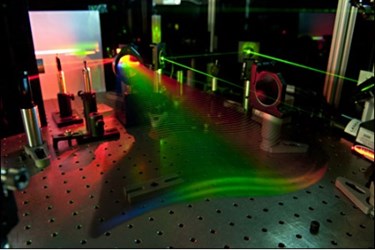Bioimaging Laser Branches Out To Bomb Detection

A method originally developed for biomedical imaging puts the possibility of bomb-detecting lasers at security checkpoints within reach.
Michigan State University chemistry professor Marcos Dantus has developed a laser that senses micro traces of explosive chemicals on clothing and luggage.
"Since this method uses a single beam and requires no bulky spectrometers, it is quite practical and could scan many people and their belongings quickly," Dantus said. “Not only does it detect the explosive material, but it also provides an image of the chemical's exact location, even if it's merely a minute trace on a zipper.
Scientists have been working for decades to develop lasers that are powerful enough for detection, but safe enough to use on people. Dantus' initial spark came from collaborating with Harvard University on a laser that could detect cancer, but that has the beam output of a simple presentation pointer.

"While working on biomedical imaging, I began exploring additional applications," Dantus said. "We soon learned how effective it was for detecting traces of hazardous substances from distances up to 10 meters away.
His bomb-detecting laser works as a single beam, but uses two pulses. The first resonates with certain chemical frequencies found in explosives. The second, a shadow pulse, serves as a reference. A discrepancy between the two pulses indicates the presence of explosive materials.
"The laser is not affected by the color or surface of clothes or luggage," Dantus said. "The resonant pulse and the shadow pulse are always in balance unless something is detected. Our method has Raman chemical specificity, excellent sensitivity and robust performance on virtually all surfaces."
This doesn’t mean that security forces will be armed with handheld lasers in airports, however. This laser more likely would be in a conveyor belt, like the x-ray scanners already used for airport security. The low-energy laser is safe to use on luggage as well as on passengers, he added.
Dantus is founder of BioPhotonic Solutions, a high-tech company launched in 2003 to commercialize technology invented by his MSU research group. He said that an aerospace company has expressed interest in furthering this technology; with additional funding, he added, a stand-alone prototype could be created in about one year.
The work, which was funded by the Department of Homeland Security, Science and Technology Directorate, appears in Applied Physics Letters.
For more information, visit www.msu.edu.
Source: Michigan State University
